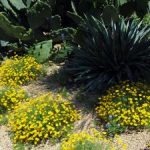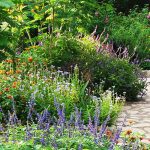WaterSaver landscapes are composed of no more than 50 percent turf — less is even better. Although some grass varieties need less water than others, all grasses require more water than mulched beds of drought-tolerant plants. (Hint, hint.)
Probably the most effective water-saving change you can make is to replace your grass with garden beds made up of hardy, water-wise plants. It’ll make a dramatic difference not only on your water bill but also in the look of your landscape.
Here are a few things to consider when deciding which part of your landscape to convert from turf to garden bed:
- Curb appeal — Visualize where a garden bed would complement the rest of your landscape and enhance your home’s architecture.
- View from inside — How would the bed’s placement look from your favorite vantage point within your home?
- Underutilized areas — Are there large spots you visit only when the grass has been mowed? These areas are ideal for conversion from turf to plants.
- Sun vs. shade — Excessive sun and shade prevent grass from growing. Create beds that’ll thrive in these conditions instead.
- Supersize it — It’s Texas after all… so if you want to make a big impression, start with the landscape beds (not the grass.) Expanding the existing beds is all you have to do, once you figure out a way to remove the surrounding turf.
Once you’ve chosen the grass area to convert, use a water hose, tape or water-based paint to outline the shape of your future water-saving bed. You may want to leave the layout for a day or two to make any adjustments.
Then you can move to the next step toward saving water — getting rid of the grass!
Removing Grass from San Antonio Water System on Vimeo.




